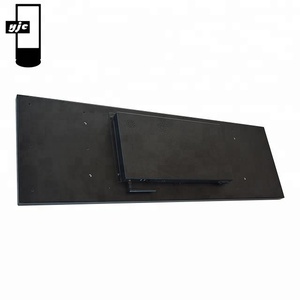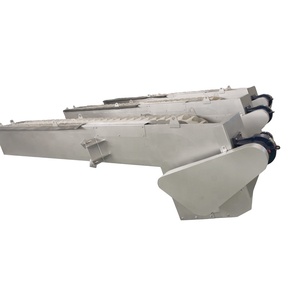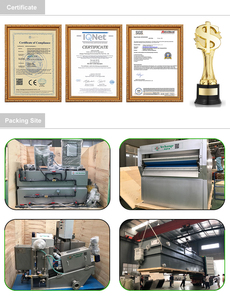
All categories
Featured selections
Trade Assurance
Buyer Central
Help Center
Get the app
Become a supplier

(3544 products available)



















































A mechanical bar screen is a type of sturdy, fixed screen that offers outstanding levels of filtration. Such screens are built from vertical bars set at specific gaps according to the required size of the screened solids. Typically, they are installed at a set angle in a water channel. A mechanical bar screen can be distinguished from an ordinary bar screen by its method of waste removal. While ordinary or stationary screens rely on gravity or manual removal, mechanical screens utilize external power for the same purpose.
Following are some different kinds of mechanical bar screens:
Architectural
Bar screens are installed across flow channels or pipelines. The screening bars, which have gaps, are typically positioned vertically. The common spacing of bars is about 20-80mm, which can be adjusted based on needs. The length and width of bar screens need to be determined according to water flow volume and the dimensions of the channels or pipelines where the screens will be installed.
Operating parameters
These parameters include bar inclinations, frequencies and cleaning water pressures. The common inclination of bars is between 60 and 85 degrees. It is also important to maintain a gap between the bars and the channel wall to enable the comprehensive screening of solid waste. The bar screen cleaning frequency depends on factors like waste types and water flow volumes. For instance, in municipal wastewater treatment, the cleaning frequency can be 2-6 times every day. The cleaning water pressure needs to be sufficient to remove the screened solids from the bars and ensure that no suspended solids pass through the bars into the subsequent treatment section. The common cleaning water pressures are between 0.2 and 0.5Mpa.
Driving methods
Mechanical bar screens are usually equipped with rude gears, worm gears and gear motors. Driving power, torque and other parameters need to be selected based on the design of bar screens, waste types and treatment needs.
Prevention and protection
Users should install protective covers or fencing around bar screens to prevent accidental contact or intrusion, ensuring work safety and reducing equipment wear. Routine checks should be conducted to ensure that the screen bars do not have any faults or damages so as to maintain effective screening and waste disposal functions.
Lubrication system
The grease used in gear drives and other components needs to be selected according to the specified grease. The grease should be proportionate to the quantity and should be evenly applied. The grease supply systems should be cleaned regularly, and the operational states of systems should be checked to ensure that lubrication works effectively.
Routine maintenance
Users should establish a routine maintenance plan and carry out mechanical bar screen maintenance as per the plan. This should include routinely cleaning the screen bars and working surfaces of bar screens, removing the impurities stuck to them, and checking whether the fasteners have loosened, ing and adjusting the tightness of the belts and chains. They should also inspect the operational states of mechanical components such as gears and bearings, and adjust their alignment as required while ensuring that they work smoothly without any abnormal noise.
Mechanical bar screens are used in different municipal and industrial applications to remove large solid wastes and protect pumps, pipelines, and treatment plants. Here are some key scenarios where mechanical bar screens are used.
Wastewater Treatment Plants
At the start of a wastewater treatment process, mechanical bar screens are placed at an angle of 60 to 90 degrees in wastewater channels or tanks. They act as primary screening devices to capture large solid wastes like plastics, debris, leaves, and rags. They are crucial for preventing damage to subsequent treatment processes, such as pumps and bioreactors.
Industrial Effluent Treatment
Mechanical bar screens are common in industries like food processing, pulp and paper, manufacturing, and petrochemical. They screen large particles, such as fibers, bottles, and food solids, from industrial effluents before further treatment. This protects downstream equipment and ensures compliance with environmental standards.
Stormwater Management
During heavy rainfall, mechanical bar screens can be used in stormwater drainage systems to prevent large solids from flowing into natural water bodies. They minimize the risk of surface water pollution and protect ecosystems.
Hydropower Plants
Hydropower plants use mechanical bar screens at the intake sections to screen out debris before water is let into the turbines. This protects the turbines from damage and ensures uninterpreted power generation.
Pump Stations
To protect the pumps, mechanical bar screens are used in pump stations. They prevent large objects from clogging the pumps and ensure smooth operation. This reduces maintenance costs and minimizes the need for manual screenings.
Combined Sewer Systems
In urban areas with combined sewer systems, mechanical bar screens are used to separate large debris from wastewater during wet weather events. This prevents clogging and overflows in the sewer system and protects downstream treatment facilities.
When choosing a mechanical bar screen for a specific application, it's important to consider several factors to ensure that the selected screen will perform effectively while also being cost-efficient.
Flow Rate and Width:
The flow rate (in GPM) and channel width where the bar screen will be installed should be determined. The flow rate directly affects the quantity of screen surface needed and the spacing of the bars. A wider channel may also require additional structural support.
Bar Spacing:
Bar spacing should be selected based on the size of objects that need to be removed. Wider spacing may let more water through but could allow some small objects to pass. Narrow spacing will catch more debris but may increase the risk of clogging.
Material and Method of Debris Disposal:
The material the bar screen is made from will need to be chosen, along with the method used to dispose of the debris. Factors like projected flow rates, debris types, screen location, and available budget can influence the options selected for this screen component.
Mechanical Screen:
It is also important to think carefully about the type of mechanical screen selected. Mechanical screens remove debris more automatically, but they also have moving parts that need maintenance. Considering the kind of debris that flow through the system will help choose between a rotary drum, an inclined rake screen, or a flat raked screen.
By considering these factors when selecting mechanical bar screens, buyers can choose screens that will effectively protect downstream equipment while also being economical to install and maintain over the long term.
Q1: What determines the price of mechanical bar screens in wastewater?
A1: Several factors will influence mechanical bar screen prices. This includes the machine’s design, the materials used to manufacture it, its capacity, the level of automation, the types of bars used, any additional features or accessories, and installation requirements and service.
Q2: Do mechanical bar screens come in different sizes and capacities?
A2: Yes. Mechanical bar screens can be adjusted to different sizes and capacities to suit specific wastewater treatment needs or fit into existing infrastructure. These adjustments might involve changing the dimensions, spacing the bars, or altering the screen's tilt and flow rates.
Q3: Can users customize any aspect of the mechanical bar screen to fit specific needs?
A3: Yes, many manufacturers allow users to customize various aspects of the mechanical bar screen, including the material used for the screen bars, the spacing between the bars, the angle and length of the screen, and the type and capacity of the motor driving the mechanistic screening system.